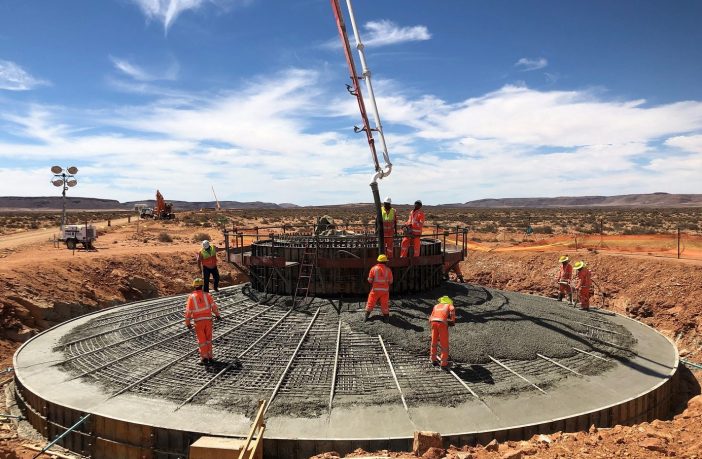- 140mw Kangnas and 110Mw Perdekraal East Wind Farm’s foundations are designed using a 70% replacement of cement.
- This equates to 32.5% reduction in CO2 from previously constructed projects.
- The projects highlight environmental performance awareness right through the construction value chain.
Perdekraal East Wind Farm poured the first of its foundations on 22 November 2018, with Kangnas Wind Farm completing the same milestone the following day. This was followed by a 28-day strength test to ensure that the foundations achieved the required design strengths.
Following the trend that started with the Bid Window3 projects, Kangnas and Perdekraal East Wind Farm’s foundations are designed using a 70% replacement of cement. This signals a significant improvement in the concrete mix design for these turbine foundations.
“We have achieved a significant improvement in the concrete mix design for these turbine foundations, with the carbon footprint of the concrete mix design being reduced by 32.5% in CO2 from our round 3 projects. For a project the size of Perdekraal East Wind Farm, it means a saving of approximately 1900tons of CO2, in relation to the previous concrete mix design,” explained Christo Loots, Construction Programme Manager for the Perdekraal East and Kangnas Wind Farms.
A carbon footprint is defined by the total amount of greenhouse gases produced to directly and indirectly support human activities, expressed in equivalent tons of carbon dioxide (CO2). “We are very pleased with the achieved reduction in our carbon footprint and value Concor’s progressive and meticulous approach to the concrete works,” added Loots.
Kangnas Wind Farm’s construction team is led by Manie Kotzé who has confirmed that 12 foundations are already complete and he expects that all 61 foundations will be in place by early July this year. To achieve this milestone on time the project relies largely on its workforce, which comprises a whopping 77% of locals from the beneficiary community of Springbok.
“Local employment is an important aspect of our construction programme, alongside skills training,” explained Kotzé, Construction Project Manager for Kangnas Wind Farm.
Similarly, Perdekraal East Wind Farm is currently providing local employment to community members of Ceres, Nduli, Bella Vista and Prince Alfred Hamlet. “Almost 70% of the workforce responsible for building the foundations come from these beneficiary communities,” said Glenn Hobson, Construction Project Manager for Perdekraal Wind Farm, who has confirmed that 8 of the 48 foundations are already complete.
Background
Kangnas Wind Farm is situated in the Nama Khoi Municipal area, in the Northern Cape. It will have the capacity to generate around 563.5 GWh/yr of clean renewable energy, enough to supply electricity to power up to 120 000 South African homes.
Kangnas Wind Farm is expected to eliminate approximately 550,000 tonnes of carbon emissions each year when compared to traditional fossil fuel power plants.
Perdekraal East Wind Farm, in the Western Cape, spans 3 055 hectares and will generate around 368.8 GWh/yr and is expected to supply electricity to power up to 95 000 South African homes. This wind farm will eliminate approximately 410 000 tonnes of carbon emissions each year compared to traditional fossil fuel power plants.
In addition to zero carbon emissions and reduced use of fossil fuels, the country will benefit from almost zero water consumption that is required during the generation process of both Kangnas Wind Farm and Perdekraal East Wind Farm.
Author: Bryan Groenendaal















